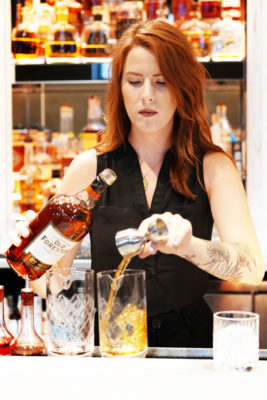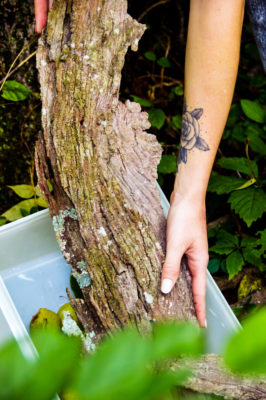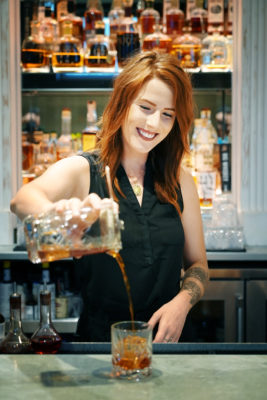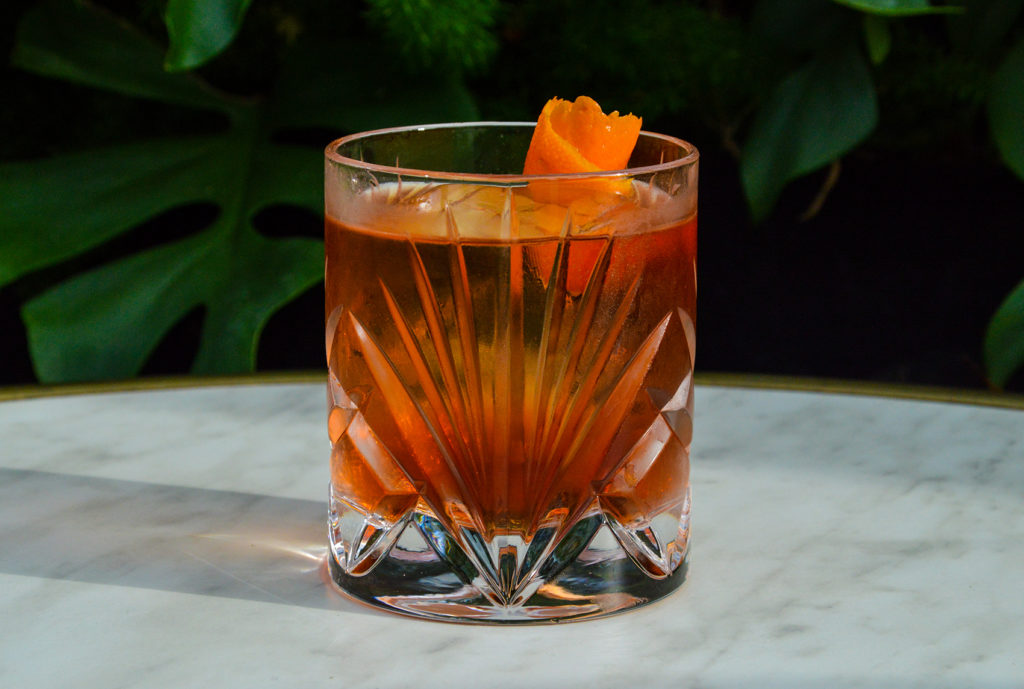It’s a Thursday night at Barn8, and the bar’s vast collection of bourbon glows a rich, golden-brown. While reclining in the warmly-lit lounge or enjoying an intimate dinner at one of the adjacent high-top tables, guests dine on the diverse selection of farm-to-table dishes and sip elegant yet balanced cocktails…though from a seat at the bar top itself, requests for the House Old Fashioned rise above the rest of the evening’s conversation, at least in terms of repetition. But this is Kentucky. One should expect to hear numerous orders for an Old Fashioned at any bourbon-serving bar in the Bluegrass.
Though in the case of Barn8, the cocktail proves more than just a regional favorite—it also serves as an elevation of the original recipe in such a way that it highlights the strength of some of Kentucky’s best bourbon. Amid the quiet chatter of the bar, we sat down with Barn8’s beverage director, Randi Densford, to talk about what it is that makes our House Old Fashioned so unique—and so classic to the Bluegrass State.
“An Old Fashioned always starts with the whiskey.”

“I believe an Old Fashioned always starts with the whiskey,” Randi expressed. “Our go-to whiskey here is Old Forester Signature 100, partly because the banana bread note in their bourbon is nostalgic for me. We had banana bread a lot when I was growing up, and something in the yeast strain they use at Old Forester gives this bourbon notes of roasted pecan and banana bread, which makes for a personal favorite of mine. I chose the 100 Proof because whiskeys with a higher proof stand up to sugars and other flavors better than those with a lower proof. And though it’s not influential on the cocktail itself, I also like to point out that Old Forester was one of the few distilleries to stay open during the Prohibition, because they were able to get a medicinal label for their whiskey. So they continued to distill all throughout that time.
“When it comes to crafting the Old Fashioned, my mentality is the simpler, the better,” Randi shared, revealing that she prefers not to use muddled fruit or sugar cubes in the cocktail and opts instead for a more modern rendition. “Pre-Prohibition they did use sugar, but the alcohol doesn’t allow it to fully dilute, so we use a syrup. Most modern Old Fashioneds use a simple syrup, but a good way to elevate the cocktail is to infuse that syrup with something, which adds to its viscosity. For our House Old Fashioned we use a foraged hickory bark rich syrup.”
“When it comes to crafting the Old Fashioned, my mentality is the simpler, the better.”
When asked about the difference between a rich syrup, such as Barn8 uses, and a simple syrup, Randi explained that it all depends on the ratio of sugar to water within the syrup. For a rich syrup, the amount of water will be less than the amount of sugar, almost making for the texture of a maple syrup, which again builds on the cocktail’s consistency. “I went with the hickory bark because I wanted to root the drink in flavors that were more earthy than fruity. Hickory tastes like burnt marshmallow to me, like something roasted.”
 Perhaps the most unique fact about the House Old Fashioned stems from the hickory syrup being sourced and crafted right here on the farm. “We only have one hickory tree on the property,” Randi said. “But it sheds its bark naturally, so we just forage what we need to from what’s already fallen to the ground. After gathering the bark, I boil it to remove any debris and then roast it in the oven until the wood sugars are caramelized. You can tell when this has happened because of the rich, sugary smell it gives off. I make the syrup separately, and once the bark has been added, it’s heated until the sugar dissolves. The bark stays in the syrup to infuse overnight, then I strain it the next day and it’s ready.”
Perhaps the most unique fact about the House Old Fashioned stems from the hickory syrup being sourced and crafted right here on the farm. “We only have one hickory tree on the property,” Randi said. “But it sheds its bark naturally, so we just forage what we need to from what’s already fallen to the ground. After gathering the bark, I boil it to remove any debris and then roast it in the oven until the wood sugars are caramelized. You can tell when this has happened because of the rich, sugary smell it gives off. I make the syrup separately, and once the bark has been added, it’s heated until the sugar dissolves. The bark stays in the syrup to infuse overnight, then I strain it the next day and it’s ready.”
After the hickory syrup has been added to the bourbon, Randi uses Angostura Bitters and housemade orange bitters by way of additives. “Then it’s traditional to use a cherry for the garnish, but for me this adds too much sweetness. I use just an expression of orange, or orange oil, to brighten the cocktail and give it just a pop of citrus, similar to the bitters we use.”
“It’s about knowing and respecting the original, knowing what makes it a classic, and then elevating it in such a way that it still leaves the strength of the drink to the bourbon.”
For the final element of the cocktail, Randi uses Kentucky Straight Ice, which is the official ice of bourbon and whiskey. Produced using limestone filtered water and cut in the shape of a perfect cube, “I believe it’s the only ice that should be used in an Old Fashioned,” Randi said. “It’s slow-melting, completely see-through, and overall makes for a beautiful finishing touch.”

The Old Fashioned, being the signature cocktail of Kentucky, proves tricky when tampered with. It’s challenging to improve upon such a well-established classic, and most variations veer too far into over-complicating the drink by adding flavors that drown out the bourbon. And while she does give it her own signature twist, for Randi the key to crafting the Old Fashioned is all about balancing the simplicity. “It’s about knowing and respecting the original, knowing what makes it a classic, and then elevating it in such a way that it still leaves the strength of the drink to the bourbon.” Based on the rate at which the House Old Fashioned is ordered at the bar, we believe most of our guests support Randi’s philosophy of mixology when it comes to this particular cocktail. We’ve included the recipe below for your own reference and encourage you to try it next time you visit Barn8—if you haven’t already!
Barn8 House Old Fashioned:
- 2 oz. Old Forester Signature 100
- .25 oz. Foraged Hickory Bark Syrup
- 2 dashes Angostura Bitters
- 1 dash Barn8 Housemade Orange Bitters
- Combine in Yarai
- Add Ice to Chill and Dilute
- Pour Over Kentucky Straight Ice
- Garnish with Expression of Orange
- Enjoy!
